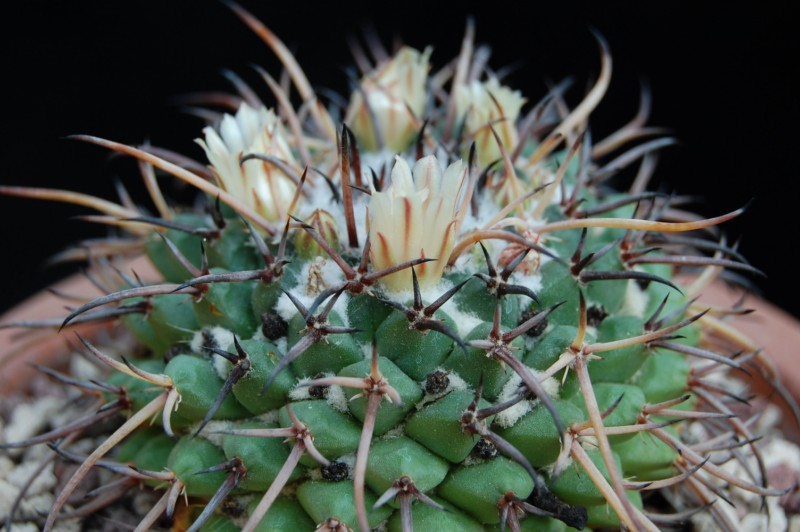Mammillaria
saint-pieana
Hunt dismissed this taxon as a synonym of Mammillaria gigantea.
Reppenhagen retains Backeberg's name for plants he found in San Luis Potosi, near Teposan/Santa Maria del Rio.
Mammillaria - John Pilbeam pag. 337
FIRST DESCRIPTION: Backeberg, Descr. Cact.Nov.3:8 (1963)
BODY: Solitary, flattened globose to globose, to 60-90 mm in diameter and 40-80 mm high, stems greyish green, sunken apex covered with wool and spines.
ROOTS: Fibrous.
SAP: With latex.
TUBERCLES: Medium set, four angled pyramidal, 10 -12 mm long and 7 - 9 mm thick.
AXILS: With white wool.
RADIAL SPINES: 4 - 7, horizontal radiating, glassy white to brown with darker tips, bristle like, straight or curving, irregular radiating, the uppermost the shortest, to 2 - 6 mm long.
CENTRAL SPINES: 2 - 4, needle like, the lowest the longest, straight, thicker at base, glassy yellow to brown with darker tips, 4 - 25 mm long.
FLOWERS: Whitish with brownish midveins, broad funnelform, 16-18 mm long and 18-20 mm wide,
FRUIT: Pinkish to whitish green, club-shaped, 20 - 30 mm long and 4 - 7 mm wide. Ripens somewhat 5 months after flowering.
SEED: Brown, drop to kidney shaped, 1 mm long and 0,8 mm in diameter. Hilum: small, white and subbasal. Selfsterile.
HABITAT SUBSTRATE: Between volcanic rocks, in cracks filled with humus.
GEOGRAPHICAL DISTRIBUTION: Mexico, San Luis Potosi near Teposan/Santa Maria del Rio. Altitude: 2000 m.
COMMENTS: Lumped by Hunt under Gigantea and by Mottram under ocotilllensis. These two species (gigantea and ocotillensis) are not growing in the neighbourhood of
saint-pieana.
Mammillaria
saint-pieana



